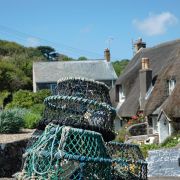Carn Euny is one of the best-preserved Iron Age villages in the south west, with nine visible hut foundations and a spectacular sixty-five foot fougou. The name 'fogou' derives from the Cornish 'fogo', meaning 'cave'. Fogous are cave-like dry stone structures, open at both ends and similar to the 'souterrains' found in Scotland and northern Europe. Little evidence as to the purpose of these fougous has been discovered, although their painstaking construction suggests that they were of great value to the community.
The large and excellently-preserved fougou at Carn Euny is the most important structure on the site, running just below the surface of the ground and roofed with massive stone slabs. A side passage leads to a round stone chamber with a collapsed roof. A small tunnel may represent a second entrance.
The site was discovered in the early nineteenth century by tin prospectors and the fougou was exposed in the eighteen sixties by the antiquarian William Copeland Borlase. The nine hut foundations were discovered and the fougou restored during extensive excavations of the site between 1964 and 1972. The excavations show that the site was a hive of constant activity from the Neolithic period right up until the late Roman period, when the village was abandoned.
Carn Euny, which is located near Sancreed on the Penwith peninsula, can be accessed at any time free of charge.







